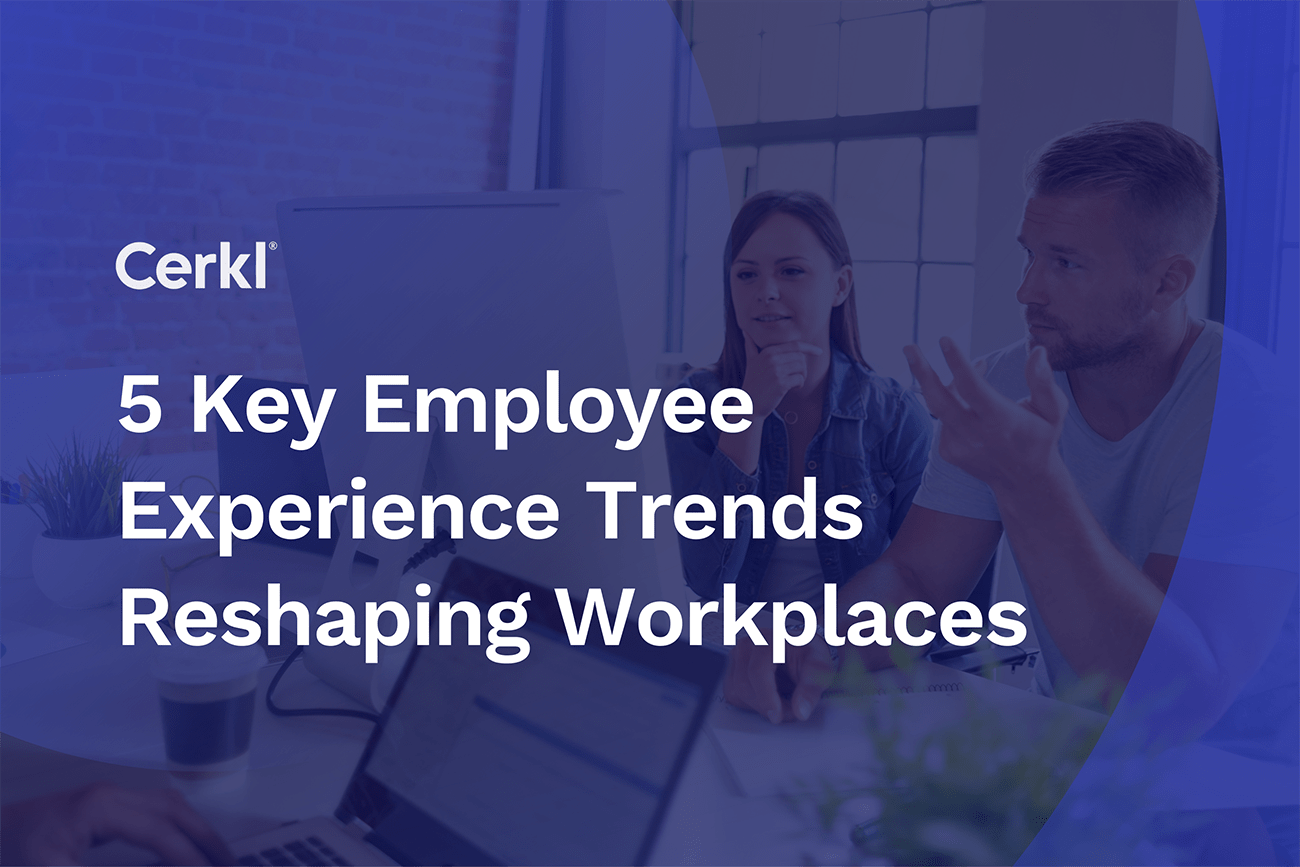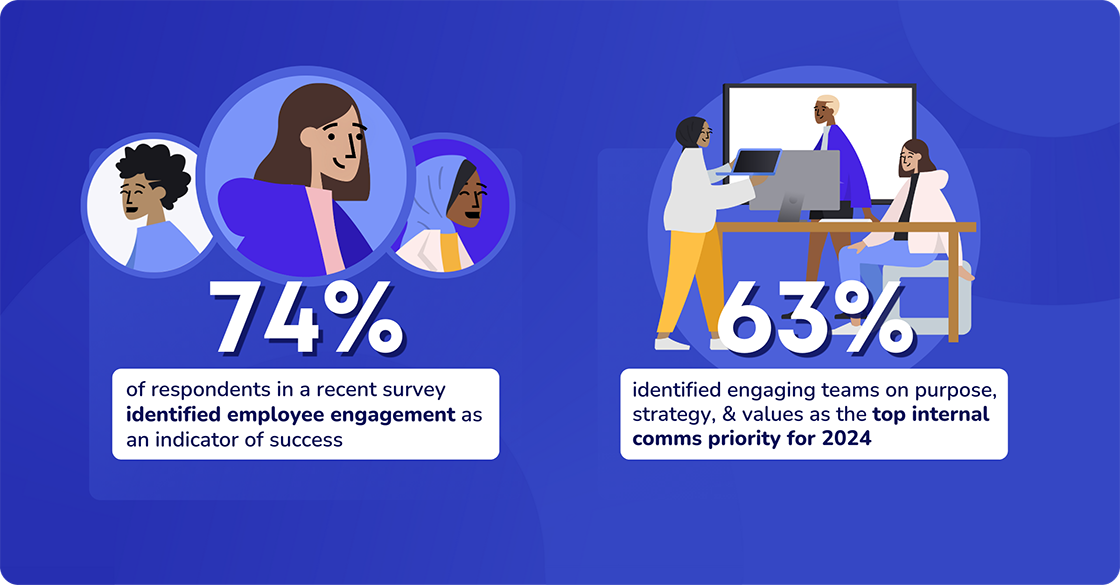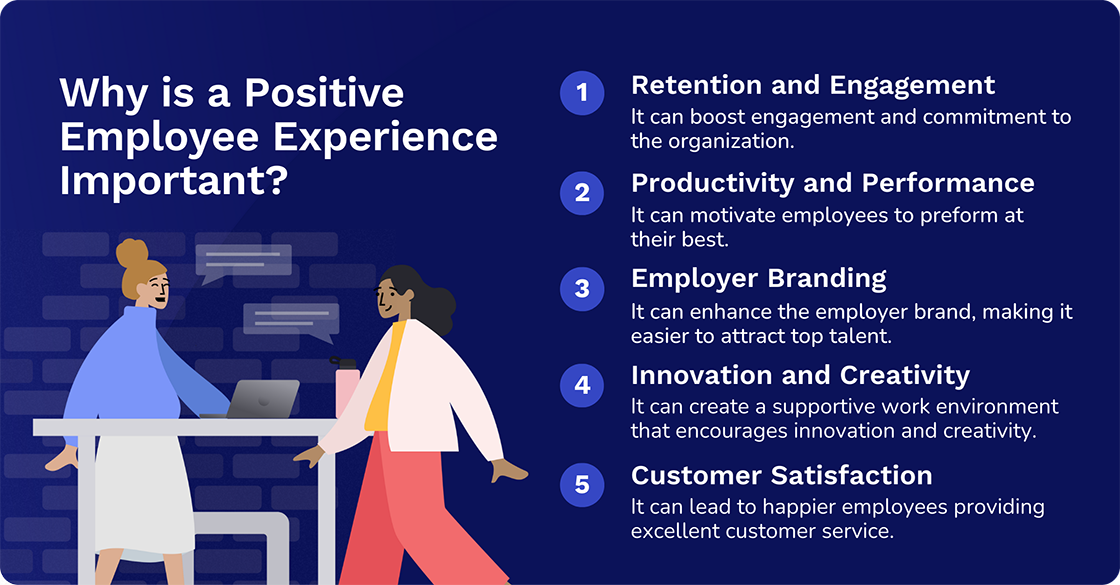Employee experience trends can have a major impact on the success of internal communications. So, we’ve identified the top five 2025 trends for you.

.webp)
Effective internal communication is the backbone of every successful organization. Learn the ins and outs of internal communications with our research-backed white paper.
Access NowEmployee experience (EX) refers to the sum of all interactions and touchpoints an employee has with their organization. These include their work environment, culture, technology, and the overall journey within the company. It encompasses everything from the initial recruitment process to ongoing engagement, development opportunities, and departure from the organization.
EX is not a new concept, but it is constantly developing. For this reason, it’s important to be aware of changing employee experience trends.
Global risk management and insurance company, Gallagher, has been tracking the evolution of the internal communication (IC) and employee experience landscape since 2008. In 2023, it was all about recalibrating IC as the scope shifted beyond hybrid working into all areas of company culture and workforce experience. In 2024, a major topic is “AI vs the human touch.” The role of internal communicators is also under the radar.
Gallagher’s definitive State of the Sector 2023/24 report details the results of their most recent survey that ran from October to November 2023. It incorporates an analysis of survey responses to find out how organizations can improve the effectiveness of communication to enhance employee understanding — and ultimately improve the all-important employee experience.
Examining the purpose of internal communication, the report states that IC success is usually judged according to levels of employee engagement measured in an annual survey. So, it isn’t surprising that 74% of respondents identified employee engagement as a success indicator. It also isn’t surprising that 63% of respondents identified engaging teams on purpose, strategy, and values as the top internal comms priority for 2024.

But disengaged employees remain a top barrier to success for 2024 just behind a lack of time of team capacity (32% vs 35%).
In this post, we’re going to share five employee experience trends we’ve identified in various research reports.
Turn your internal communications strategy around today

Prioritizing a positive employee experience is not just about creating a pleasant workplace and catering to employee well-being. It's about fostering a culture that values people, drives performance, and ultimately contributes to the success of the organization.
Ensuring a positive employee experience is crucial for several reasons:
High employee retention and engagement create a positive work environment where employees feel valued and motivated, leading to increased satisfaction and productivity. Employees who have a positive experience are more likely to be engaged in their work and committed to the organization. This leads to higher retention rates, reducing turnover costs, and maintaining institutional knowledge and commitment.
Satisfied employees are more productive and tend to deliver higher-quality work. A positive experience fosters a sense of purpose and belonging, motivating employees to perform at their best.
A good employee experience can enhance the employer brand, making it easier to attract top talent. Furthermore, satisfied employees are more likely to share their positive experiences, acting as ambassadors for the company.
A supportive and inclusive work environment encourages innovation and creativity. When employees feel valued and empowered they are more likely to contribute new ideas and take risks.
Happy employees often lead to an increase in satisfied customers. Employees who feel supported and motivated are more likely to provide excellent service, leading to higher levels of customer satisfaction and loyalty.

Turn your internal communications strategy around today

So what can we expect from the remainder of 2025? What changes and trends will emerge as a result of the way organizations are looking into employee experience?
Here’s our list of the top five trends gleaned from relevant research and survey reports. All these employee experience trends are expected to reshape the workplace this year.
Generative (Gen) Artificial Intelligence (AI) captured public attention globally after the launch of ChatGPT in 2022. It was too late to include it in Gallagher’s 2022/23 survey, but they introduced the topic in the 2023 survey to identify how communicators are using AI. They also wanted to assess the impact internal communicators believe it will have on their roles and the field of communications.
Asked how they feel about AI, 41% said they were enthused, 35% admitted being resigned to it, 13% were in denial, and 2% said they were “terrified.” The remaining 9% are understood to be championing its use. The survey found that those using AI are the most positive about its potential.
Asked what impact they believe technology will have on internal communications over the next five years, 44% of respondents put AI at the top of the list.

Gartner also identifies AI as a major future of work trend for 2025. They state that while many employees are convinced that AI will result in job cuts, it’s much more likely to create jobs.
The caveat is that GenAI experiments are likely to produce “hard lessons and painful costs.” Risk management is the key to overcoming these.
“We foresee AI actually enhancing workforce opportunities. Not only will implementing GenAI create the need for new roles, but it will also allow employers to reduce time to proficiency with new technology and specializations, easing the need to hire talent already skilled in these areas.”
Gartner
Sarah Marrs, who worked for the EX platform, Qualtrics, for nine years, puts AI into perspective.
“Engaged employees who have a positive experience will see AI as enhancing that experience, but those who feel a lack of trust will see it as increasing the poor behavior and decisions they believe they have seen.”
Sarah Marrs
Qualtrics Employee Experience Trends 2024 report states that frontline employees are not getting their basic needs met by their organization. These people have challenging roles that typically keep them on their feet all day.
According to Matt Evans, frontline workers don’t feel recognized. They aren’t satisfied with the financial rewards they get, and they are unhappy about the lack of growth and development opportunities offered to them. “Frontline workers simply do not feel appreciated.”
The Qualtrics survey shows:
This shows that frontline workers are less trusting of leadership than other employees. They don’t feel empowered to speak their minds.
The message here for leaders is that they need to pay attention to frontline employees. After all, they are closest to your customers and products. Feedback from all employees is vital — and frontline workers must never be left out of the loop. Have a conversation. Listen to their challenges and unmet needs. By valuing their firsthand experiences, organizations can unlock fresh ideas and empower frontline workers to participate and become involved.
They also want employers to be more flexible! The Qualtrics EX report warns that there isn’t a one-size-fits-all approach. This means that employers need to find out how individual employees work best.
Their research shows that when employees work a five-day week on-site or in an office, their EX metrics are the lowest across the board. On the other hand, those who work a hybrid schedule have the highest EX metrics.
“Start by empowering managers and leaders to develop flexible work plans for their teams. Setting minimum expectations, along with the autonomy to make adjustments that work for them, will ensure the best outcomes for both employees and the organization.”
Qualtrics
According to McKinsey, giving employees flexibility without encouraging “purposeful presence” and establishing clear norms, has less impact. Nevertheless, when employees have the freedom to choose when or where to work this results in a:
Organizations can start by empowering managers and leaders to develop flexible work plans for their teams. Setting minimum expectations, along with the autonomy to make adjustments that work for them, will ensure the best outcomes for both employees and the organization.
For example, McKinsey also shows that when teams establish clear expectations for when, where, and how employees must work, this results in a:
The Qualtrics EX report indicates that passive listening results in less trust. That’s why it’s so important to build trust through clear communication and employee engagement.
Mercer surveyed more than 12,200 C-suite executives, HR leaders, employees, and investors, for its 2024 Global Talent Trends report. One focus was the importance of having an anchor to trust and equality. While trust hit an all-time high in 2022, this survey found that trust is wavering.
Even though employee trust in their organizations is still strong, it has decreased significantly over the past few years. Mercer’s research found that:
Frequent restructuring breeds uncertainty, making employees less invested in change. They might simply wait for the next upheaval.
However, trust is key. Employees who trust their company are twice as likely to flourish. Mercer found that employees who trust their organization are twice as likely to be thriving. But what helps them to thrive?
Additionally, employers are expanding the objectives of their DEI initiatives to include fostering a sense of belonging.
According to Harvard Business Review, in 2024, companies will begin to make embedding DEI throughout the organization a pivotal priority. This approach will change how business leaders interact with DEI, positioning it not as “what” they do, but “how” they achieve high performance in their key objectives.
Culture and employee experience interlinked. A strong company culture acts as the bedrock, shaping the core values employees experience. Employee Experience (EX) then builds upon this foundation, focusing on how employees navigate and feel throughout their journey within that culture.
A survey by isolved of 1,100 full-time U.S. employees shows that 84% of employees are satisfied with their jobs. But it’s not a good story.
Uncovering the significant HR Trends of 2024 to Maximize Your Next-Best Step also shows that
When it comes to ways HR can boost culture, “improve internal communications” beats “pay employees market value.” The survey revealed a strong indication that internal comms is a vital area employers should focus their efforts on. Nearly half (41%) replied “no” or said they were when asked if management communication about things like company performance and goals was adequate.
When asked which HR activities should be improved. The top three activities identified were:
Perhaps more importantly, when asked how employers should improve employee engagement, more than half said they wanted more opportunities to develop their skills.

While trends are always changing, one element that remains vital is internal communications. Do you appreciate how important IC is? We know it is crucial and are happy to share our white paper on The Importance of Internal Communication with you absolutely free.
This valuable resource dives deep into how IC can:

Turn your internal communications strategy around today
What is the future of employee experience? The future of employee experience is all about personalization and flexibility. Emerging trends like AI and remote work will shape how companies cater to individual needs and preferences.
What improves employee experience? Strong leadership, clear career paths, and opportunities for growth all contribute to a positive employee experience. Feeling valued and supported by the company is key to employee satisfaction.
What is the most impactful employee experience trend in 2025? AI is having a major impact on the employee experience in 2025. AI can automate tasks, personalize learning, and even provide mental health support, all contributing to a more positive work experience.

Turn your internal communications strategy around today